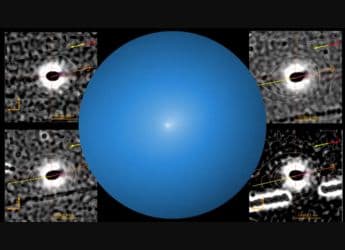- Home
- Science
- Science News
- NASA’s Perseverance Rover Investigates Strange Martian Rock
NASA’s Perseverance Rover Investigates Strange Martian Rock
NASA’s Perseverance rover examines a complex Martian rock, collects rare minerals, and sets a new driving record.

Photo Credit: NASA/JPL-Caltech
Perseverance explores “Kenmore” for minerals and sets a new Mars driving record
NASA's Perseverance rover had just finished inspecting a Martian rock called “Kenmore,” and the results held information about its mineral composition and information about long-ago conditions on Mars. Once the surface was chewed up a bit, the rover extended a number of onboard instruments to analyse its contents; it reports finding clay- and manganese-rich minerals. Despite its tricky grinding behaviour, researchers were actually able to perform a full geochemical analysis of the rock. Such results contribute to the library of science that could support a potential future human mission to Mars and eventual lifestyles on Mars.
Perseverance Discovers Water-Rich Clays and Breaks Drive Record in Latest Mars Rock Study
As per NASA's Jet Propulsion Laboratory, Kenmore marked the 30th rock abraded since Perseverance landed at Jezero Crater. The rover's Dust Removal Tool (gDRT) fired controlled nitrogen bursts to clear the rock's surface, enabling instruments like WATSON, SuperCam, SHERLOC, and PIXL to conduct imaging and spectroscopy. SuperCam detected clay rich in water-bound hydroxides, while PIXL identified manganese hydroxide — a first in this mission. Feldspar was also detected, linking the rock's origins to ancient planetary processes.
Abrasion allowed a detailed look beneath Mars' dusty surface. The tailings were imaged and spectroscopically analysed and found to contain relative concentrations of iron and magnesium that are similar to hydrated minerals. The team emphasised the advantage of using gas-based cleaning methods over Earth-contaminated brushes. The comprehensive analysis supports long-term goals of determining potential for water storage, fuel extraction, and building materials.
Perseverance also broke its previous autonomous drive record on June 19, travelling 1,348 feet — equivalent to 4.5 football fields. Engineers credited AutoNav for the accomplishment, with rover drivers precisely stopping at a predetermined target. This is evidence of the rover's capability to very efficiently cover ground as it scouts out an area of great scientific interest.
As Perseverance sheds its new-light-of-day innocence and builds mileage climbing Jezero's rim, the more scientists learn about the surface chemistry and terrain of Mars. Every sample New Frontiers brings home helps paint a more complete picture of the history of our neighbouring planet and will make possible the safe return of astronauts, and may eventually be returned to Earth.
Get your daily dose of tech news, reviews, and insights, in under 80 characters on Gadgets 360 Turbo. Connect with fellow tech lovers on our Forum. Follow us on X, Facebook, WhatsApp, Threads and Google News for instant updates. Catch all the action on our YouTube channel.
Related Stories
- Samsung Galaxy Unpacked 2025
- ChatGPT
- Redmi Note 14 Pro+
- iPhone 16
- Apple Vision Pro
- Oneplus 12
- OnePlus Nord CE 3 Lite 5G
- iPhone 13
- Xiaomi 14 Pro
- Oppo Find N3
- Tecno Spark Go (2023)
- Realme V30
- Best Phones Under 25000
- Samsung Galaxy S24 Series
- Cryptocurrency
- iQoo 12
- Samsung Galaxy S24 Ultra
- Giottus
- Samsung Galaxy Z Flip 5
- Apple 'Scary Fast'
- Housefull 5
- GoPro Hero 12 Black Review
- Invincible Season 2
- JioGlass
- HD Ready TV
- Laptop Under 50000
- Smartwatch Under 10000
- Latest Mobile Phones
- Compare Phones
- Honor Win RT
- Honor Win
- Xiaomi 17 Ultra Leica Edition
- Xiaomi 17 Ultra
- Huawei Nova 15
- Huawei Nova 15 Pro
- Huawei Nova 15 Ultra
- OnePlus 15R
- Asus ProArt P16
- MacBook Pro 14-inch (M5, 2025)
- OPPO Pad Air 5
- Huawei MatePad 11.5 (2026)
- Xiaomi Watch 5
- Huawei Watch 10th Anniversary Edition
- Acerpure Nitro Z Series 100-inch QLED TV
- Samsung 43 Inch LED Ultra HD (4K) Smart TV (UA43UE81AFULXL)
- Asus ROG Ally
- Nintendo Switch Lite
- Haier 1.6 Ton 5 Star Inverter Split AC (HSU19G-MZAID5BN-INV)
- Haier 1.6 Ton 5 Star Inverter Split AC (HSU19G-MZAIM5BN-INV)

















